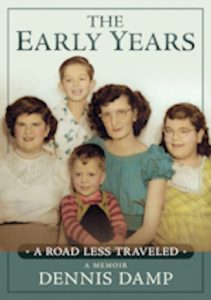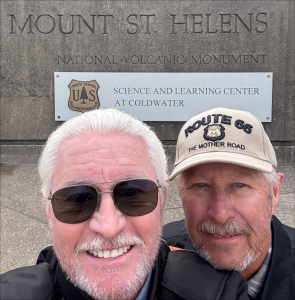Posted on Thursday, 24th July 2025 by Dennis Damp
 Print This Post
Print This Post
Kiplinger Retirement Newsletter’s recent article, “How to Tell Your Own Life Story,” was on the mark. They say, “There is one vulnerable asset we tend to overlook: Our stories.” This is so true, and it was a driving force behind my decision to write and publish my memoir, “The Early Years, A Road Less Traveled,” in 2020.

This is not a self-promotion for my memoir, which is out of print. Actually, I gave away most of the copies. I wrote it for family, friends, and those who have followed my columns, blogs, and websites for decades.
I wanted my children and grandchildren to know how their ancestors lived and struggled to make ends meet, nurture, and raise a family during austere times. A personal family history that family members can cherish and pass on long after I’m gone. Hmm, where am I going?
Today’s generation and our children were raised in a completely different manner from how my wife, Mary, and I were raised in the 1950s and 1960s. What most people take for granted today were profound and unimaginable luxuries during my childhood.
Regrets – I have a Few
I can’t tell you how many times I regret not asking my mother, aunts, and uncles about their early lives. Just sitting down with them and having a frank discussion about their recollections would have been revealing. New generations need to hear about how different and difficult everything was for many of those who came before them.
Simple things – I loved my mother’s macaroni and cheese, and I don’t have her recipe. It didn’t have the consistency of today’s offerings; it had a burnt cheese crust that we fought over at dinner time. I’ve tried to replicate it several times without success. Fortunately, I have snippets of my family’s history that I included in my memoir.
I knew little about my mother’s early years; her parents had 10 children. They made ends meet, all they could do on a coal miner’s salary in those days. It could also be due to the fact that she, along with her brothers and sisters, never had much of a childhood at all.
My mother and most of her siblings were forced to drop out of school after the 6th grade and were sent to work throughout the Pittsburgh area. My mother worked as a maid for $2 a week, which included room and board. She was just 13 years old! Her father collected all but 25 cents of her weekly salary!
Here is What’s in the President’s New Spending Bill
Your Story
James Hagerty, the author of Kiplinger’s article, says, “Your story may be the best gift to your friends and family, and it’s a gift only you can give.” Yes, others know bits and pieces of your story, but even those recollections are often diminished by time and circumstance. You are the key to presenting the story firsthand without others’ interpretations.
Tom, a friend I worked with for many years, relayed stories of growing up in Swissvale in the 1960s. I lived just down the street in Wilkinsburg, PA. We would often swap tales of our misadventures, and Tom would talk about his escapades with his cousins, family, and friends, which I always found interesting. These adventures and our early memories are the foundation for starting a memoir or whatever you want to call it.
I wonder if Tom’s family knows about the huge model boat he discovered in the wall of a condemned building and what he did with it, or many of the other youthful antics. Probably not, but they would find them amusing.
On the Mark, Get Set, Go!
The hardest part of any endeavor is getting started; once you commit, a routine emerges, and things start to fall into place. My first step was to write the Preface, which essentially summarizes what the book is about from a personal perspective with succinct observations. An excerpt from my Preface follows. Can you envision where I was going with my memoir?
“Life in the mid-twentieth century was all one could imagine of that time, a Forrest Gump world running at a snail’s pace. The only cell phone we encountered was in the comic strips when Dick Tracy was all the rage. Computers were relegated to large research facilities, filling huge rooms with vacuum-tube equipment racks that emitted ambient light and illuminated the room’s interior.
Airplanes were becoming increasingly popular after World War II, but most still relied on trains and trolleys to get where they needed to go. The middle class bought cars and homes at a feverish pace, yet most could only dream about living the “life of Riley,” an expression coined from an early 1950s TV sitcom. We watched Father Knows Best, The Donna Reed Show, and others that represented the ideal traditional family, infusing our dreams with visions of a stable, satisfying life surrounded by family and friends.”
Towards the end of the Preface, I go on to state, “This is my story, a collection of recollections from a life filled with high expectations, daunting challenges, and a large dose of reality, experienced in a multitude of environments and circumstances. All of which helped me become who I am today. It’s a story of our family’s early trials, tribulations, and successes all rolled into one.”
A Preface sets the tone of the book; without it, it’s equivalent to traveling across the country without a map or GPS. I included the complete Preface, Dedication page, and Chapter One for all to read on my site.
As a courtesy to my dedicated followers, I’ll post a PDF file on my site each week with another chapter of my memoir. You can now read Chapter Two online. The chapter will be available for only one week, after which another chapter will be posted.
Your Story Outline
The next step is to develop a story outline that highlights the times in your life or events you wish to share with family and friends. I began with my mother and father’s early lives, including how they met, and provided a brief overview of their families. Then, I focused on each stage of my life, to age 35 and beyond.
Your story can focus on anything you wish to share with others, or on a specific event in your life. Jack Myrtha, a member of my parish, wrote an exceptional memoir called “The Hunny Bunny: A Young Girl’s Life with a Congenital Heart Defect,” which is both tragic and beautiful. A heart-wrenching journey about his beautiful daughter Katie’s short life and the trials and tribulations they encountered through her life’s journey.
John and Krista Myrtha were staunch patient advocates for their daughter, questioning caregivers and researching her affliction to ensure their daughter received the best treatment possible from those who cared for her.
Charles Coulter, the father of good friends of mine, aggressively researched their family history throughout his life. He and other family members developed an extensive family tree, and Charles wrote a book on the subject many years ago that he passed onto to his children. The Coulter brothers have relatives across the country and believe they are related to John Colter, the famous western explorer, that was on the Lewis and Clark expedition.
What Story Will You Tell?
I wrote my memoir because my early childhood made me stronger, teaching me to appreciate what we have, spend with care, focus on the family, and save for a rainy day. Hopefully, it will help our children and grandchildren appreciate what they have and the support they received in life.
Many today still struggle to make ends meet and put food on the table, a situation I recall well from my youth. It doesn’t matter where you came from, whether you’re rich or poor; everyone has interesting and inspirational stories to share with others, what they did, and how they got to where they are today. Hopefully, with helpful suggestions and perspectives for those who will follow us in this life. The who, what, where, and why of our existence.
What do you want your family and descendants to know about your life? No matter what it is —a biographical sketch or a major event —once written, you will discover immense satisfaction from the effort, and your family will appreciate having your memories preserved and passed on to future generations.
The Long and Short of It
You don’t have to write a formal book; you can if you wish, and there are many companies that will help you compile your work if needed. It can be a handwritten journal, a file on your computer, or printed out using Microsoft Word or any other word processor. You can even package a photo journal at Walmart or other stores.
Bob and Gary Coulter, traveled cross-country from Pittsburgh, PA, to California and back twice over the past three years on Harley motorcycles. By the way, one of the two was 80 years old at the time! Bob’s daughter used their pictures to compose a beautiful travel journal at Walmart for her dad and uncle. A treasured keepsake that the entire family and friends enjoyed.

Gary & Bob Coulter’s Cross-Country Trip
Don’t be concerned about your writing style, grammar, or spelling; software programs will help you through all of that and much more. Once started, you will be drawn into the work and think of little else until it’s finished.
The beauty of writing a memoir is that no standard format applies; make it whatever works for you. Most of the memoirs I’ve read had few pictures; I used 144 photographs in my book, each accompanied by captions, and included a family history that I compiled over the years.
Pictures add a personal experience, such as my son’s first haircut, prom and wedding pictures, family gatherings, and so much more. Pictures can be lost, but a book is an archive of your life’s experiences and can be passed on for generations.
Don’t procrastinate; time passes, and your initial interest may fade along with your memories. My memoir was on my bucket list for over a decade, and of the 28 books I’ve written, it was by far the most enjoyable project I’ve ever worked on. Two years well spent. Our time on this earth is finite, and at 76, I’m acutely aware of life’s limitations, which my body reminds me of daily.
As a final note, I was unable to provide a link to the Kiplinger article because it is only available to Kiplinger Retirement Report subscribers.
Helpful Retirement Planning Tools
Join other federal workers on the FedWork Network.
Sign up for this Free Service to get started.
- Financial Planning Guide for Federal Employees and Annuitants
- TSP Guide
- Budget Work Sheet
- Retirement Planning for Federal Employees & Annuitants
- The Ultimate Retirement Planning Guide – Start Now
- Deciding When To Retire – A 7-Step Guide
- 2025 Federal Employee’s Leave Chart
- Medicare Guide
- Social Security Guide

Over time, various dynamic economic factors relied upon as a basis for this article may change. The information contained herein should not be considered investment advice and may not be suitable for your situation. This service is not affiliated with OPM or any federal entity. You should consult a financial, medical, or human resource professional where appropriate. Neither the publisher nor the author shall be liable for any loss or other commercial damages, including but not limited to special, incidental, consequential, or other damages.
Last 5 posts by Dennis Damp
- The 2026 Landscape: What to Expect and Outlook - January 1st, 2026
- Long Term Care Insurance - Future Purchase Option - December 12th, 2025
- Open Season Coming to a Close – Last-Minute Checkup - December 2nd, 2025
- I Rolled Over My TSP Account to an IRA – Should You? - November 21st, 2025
- The 2026 FEHB & PSHB Open Season Selection Guide - November 6th, 2025
- Medicare & You 2026 – Significant Changes on the Way - October 31st, 2025
- A 30-second Check Could Change Your Retirement Plan - October 20th, 2025
- Prescription Drug Costs – Major Price Cuts Coming - October 17th, 2025
- Government Shutdown Continues – Suffering the Consequences - October 15th, 2025
- Health Care Premiums Announced for 2026 – Hold on to your Hat! - October 13th, 2025
- Inflation Concerns and High Prices Persist – What’s Next - October 10th, 2025
- Roth Conversion Article Update and Income Tax Impact - September 25th, 2025
Tags: Daily Brief, Growing up in the 1950s and 1960s, Life Story, Memoir, Preserving YOUR Story, Taking Stock of Your Life
Posted in ESTATE PLANNING, LIFESTYLE / TRAVEL, RETIREMENT CONCERNS, SURVIVOR INFORMATION | Comments (0)
 Print This Post
Print This Post


